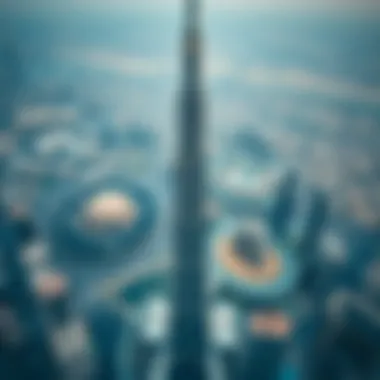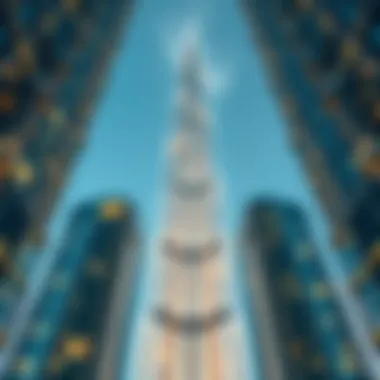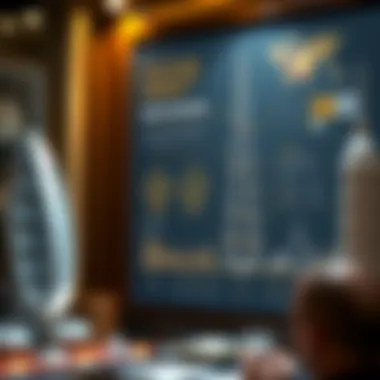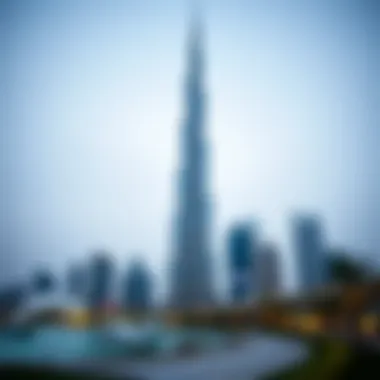A Comprehensive Look at the Burj Khalifa Project


Intro
The Burj Khalifa is not just another skyscraper; it’s a beacon of possibilities that says a lot about ambition and progress. Standing tall at a staggering height, it reshaped Dubai’s skyline and set the tone for modern architecture. But this towering structure represents more than just height; it serves as a barometer for the real estate market in the UAE.
Understanding how the Burj Khalifa came to life involves looking at its architectural brilliance and the engineering marvel that it is. From its conception to its grand opening, each phase echoes an understanding of cultural significance, innovative design, and market implications.
As we unfold layers of this project, it’s essential to look at current trends and opportunities within the Dubai real estate sector, influenced by this iconic structure. This analysis will not only highlight the project itself but also serve as a guide for investors, agents, and anyone keen on navigating Dubai’s dynamic property landscape.
Overview of the Burj Khalifa Project
The Burj Khalifa stands as a monumental testament to modern engineering and design. It is not merely a building; it is a symbol of ambition, innovation, and the transformation of Dubai into a global city. Understanding the overview of this iconic project is essential for investors, real estate agents, and other stakeholders interested in the dynamics of urban developments.
The project itself encapsulates several key elements that are crucial to grasp:
- Architectural Design: The Burj Khalifa showcases what cutting-edge design can achieve, featuring a unique blend of Islamic architecture with modern aesthetics.
- Engineering Challenges: During its construction, the Burj Khalifa faced numerous structural challenges, making its completion an extraordinary feat of engineering prowess.
- Cultural Impact: Beyond its physical structure, the Burj Khalifa plays a significant role in shaping Dubai’s global image, attracting millions of tourists and establishing itself as a cultural landmark.
- Economic Influence: The tower has significantly impacted Dubai’s real estate market, enhancing property values and boosting investment opportunities in the surrounding areas.
Investing time in understanding the Burj Khalifa project means appreciating not just the visible skyscraper, but the complex ecosystem surrounding it. This encompasses everything from the historical context that birthed such an iconic structure to the economic strategies that leverage its existence. All these aspects intertwine to form a narrative that is as compelling as the building itself.
Historical Context
To appreciate the Burj Khalifa's significance, one must first delve into its historical context. Dubai's rapid transformation from a small fishing village into a thriving metropolis gave rise to numerous developmental projects, but none as ambitious as the Burj Khalifa.
In the early 2000s, Dubai was on the verge of a global change. The decline in oil prices and a search for economic diversification prompted the UAE government to invest heavily in tourism and real estate. Visionary leaders conceptualized the Burj Khalifa project as an anchor to draw visitors into the emirate, aiming to redefine its skyline while also attracting business and tourism.
Project Genesis
The genesis of the Burj Khalifa began with a desire to create not just a building but a statement. In 2004, the plans took shape when the architecture firm Skidmore, Owings & Merrill was chosen to design the tower.
The official name, “Burj Khalifa,” pays tribute to Sheikh Khalifa bin Zayed Al Nahyan, reflecting the deep-rooted connections between Dubai and the UAE's leadership. This project symbolizes unity and ambition—a beacon for future developments in the region.
From the outset, the project attracted a myriad of international stakeholders, making it a collaborative achievement of many cultures. It wasn’t only about building higher; it was about building better and smarter, employing technologies and materials that would set a new standard in the construction industry.
In synthesizing this history with the project's origins, stakeholders can gain valuable insights into the driving forces behind the Burj Khalifa, making it not just a landmark but also an integral part of Dubai's ongoing story.
“The Burj Khalifa isn't just a building; it embodies the dreams of a nation.”
Architectural Mastery
The Burj Khalifa is not just a building; it represents the pinnacle of architectural mastery and innovation. In this section, we explore how the Burj Khalifa has set a precedent for future skyscrapers, establishing an understanding of the intricate blend of art and science that characterizes modern architecture. Investors and enthusiasts alike can appreciate how this landmark catalyzed advancements in design, structural integrity, and urban development, serving as a blueprint for projects around the globe.
Design Philosophy
The design philosophy behind the Burj Khalifa is deeply rooted in its cultural context and the ambition of Dubai as a city. Designed by the renowned architectural firm Skidmore, Owings & Merrill, the structure draws inspiration from traditional Islamic architecture while embracing a contemporary aesthetic. The building’s silhouette resembles a desert flower, symbolizing growth and aspiration.
The architects wanted to create more than just a tall building; they envisioned a harmonious relationship between the structure and its surroundings. The podium design echoes the natural landscape, connecting the Burj Khalifa with the earth and the skyline seamlessly. The careful choice of line and form allows the skyscraper to appear slender, stretching towards the sky yet anchored to the ground. This philosophy not only enhances visual appeal but also fosters community engagement, making the Burj Khalifa a true landmark.


Structural Challenges
Building the world’s tallest structure is no small feat, and the Burj Khalifa faced numerous structural challenges during its construction. One of the notable challenges was the sheer height of the tower, which necessitated innovative solutions to ensure stability and safety. The building’s core, consisting of a reinforced concrete central core and a series of wings, is a marvel in itself. This design helps in distributing wind loads effectively, which is crucial for a structure of this height.
Moreover, construction in the extreme temperatures of the desert posed additional hurdles. Workers had to contend with soaring heat during the day and freezing temperatures at night. The use of specialized concrete mixtures and temperature management techniques during pouring were vital in overcoming these obstacles.
"The Burj Khalifa is not just an architectural achievement; it’s a test of engineering resilience and innovation."
Materials and Technology
The Burj Khalifa utilizes cutting-edge materials and technology, reflecting a significant investment in modern construction practices. More than 103,000 square meters of glass and 103,000 square meters of steel were employed, contributing to both aesthetics and functionality. The glass façade provides stunning views while minimizing energy consumption through its heat-reflective properties.
In addition, advanced construction technologies were integrated into the project. High-performance elevators designed by Otis can travel up to 10 meters per second, reducing waiting time and improving accessibility. The sophisticated Building Management System ensures that all systems operate efficiently, controlling everything from heating to security with precision.
This combination of superior materials and state-of-the-art technology, alongside an innovative approach to design, not only enhances the building's durability but also sets a standard for future skyscrapers around the world. Investors looking into high-rise projects can draw valuable lessons from the materials and technologies applied in the Burj Khalifa.
Engineering Feats
The engineering accomplishments behind the Burj Khalifa extend beyond conventional boundaries, shaping not only the skyline of Dubai but also influencing skyscraper construction globally. These feats underscore the project’s significance in demonstrating advanced engineering principles that challenge existing paradigms. For investors, understanding these achievements is crucial as they reflect a commitment to quality and innovation, enhancing property value and attractiveness in a competitive market.
Construction Techniques
In crafting the Burj Khalifa, the construction techniques employed were quite revolutionary. The building stands at an extraordinary height of 828 meters, which led to the adoption of the buttressed core structural system. This design feature allows for load distribution efficiently, vital for tall structures subject to wind forces. When you think about it, using reinforced concrete helped not just in ensuring stability but also in reducing the weight compared to traditional steel structures.
However, the logistics of construction were no small potatoes. The use of a high-capacity crane allowed workers to build at dizzying heights, reaching levels that were once seen as unattainable. The pumping system was also groundbreaking; concrete was pumped to heights exceeding direct reach, ensuring a continuous pour that maintained the integrity of the structure.
"The construction of the Burj Khalifa was a manifestation of human ingenuity; it was not just about height but about redefining possibilities in engineering."
Safety Protocols
Safety is paramount in any construction project, but for a structure of this magnitude, it was taken to the next level. The Burj Khalifa implemented rigorous safety protocols. From the outset, comprehensive risk assessments were carried out. Measures such as advanced fire safety systems, which include not just sprinklers but also smoke detection and adaptable evacuation systems, reflect a proactive approach to safety.
Moreover, the application of wind tunnel testing during the design phase ensured that the building could withstand the environmental forces acting upon it. Workers were periodically trained and subjected to drills aimed at preparing them for emergency situations. In addition, structural redundancy was ingrained in the design, which minimizes risks related to potential failures.
Innovations in Skyscraper Design
The Burj Khalifa redefined innovations in skyscraper design in several ways. One standout feature is the tripartite design, inspired by traditional Islamic architecture. This design not only adds aesthetic appeal but also optimizes the building's performance against wind forces—a crucial consideration for such towering structures.
Furthermore, modern materials used in construction, including advanced composites and high-strength glass, significantly contribute to energy efficiency. Features such as the double-skin façade not only enhance thermal insulation but also reduce energy consumption for heating and cooling. This is particularly important in Dubai's climate, where temperatures can soar.
Investors looking into skyscraper developments can take a page from the Burj Khalifa’s playbook, observing how thoughtful engineering can lead to enhanced sustainability, which is increasingly valued in today’s market.
In sum, the engineering feats of the Burj Khalifa not only represent triumphs of human capability but also serve as a touchstone for future projects. Alongside architectural magnificence, these elements underscore the potential ROI for investors keen on sustainable and groundbreaking developments.
For further reading, consider looking into resources like Britannica or insights shared on Reddit for community perspectives on skyscraper engineering.


Economic Implications
The Burj Khalifa serves as not just a premium construction marvel but also as a significant focal point for evaluating economic implications, both locally and globally. Understanding these aspects is crucial for investors, real estate agents, and stakeholders who wish to navigate the market with insight. The economic consequences surrounding this skyscraper extend beyond traditional investment analysis and touch on broader trends impacting Dubai and the global landscape.
Investment Analysis
Investing in real estate surrounding the Burj Khalifa is like placing a bet on the future of modern architecture and urban development. Properties in this vicinity have consistently shown robust appreciation, largely thanks to the tower’s status as an international landmark. For instance, according to local reports, residential units in the vicinity can command prices significantly higher than similar properties elsewhere in Dubai.
Key Takeaways for Investors:
- Return on Investment (ROI): The average price for luxury apartments near the Burj Khalifa has demonstrated a 10% annual increase in recent years, offering appealing returns.
- Rental Demand: High demand for short-term rentals has been buoyed by the attraction's tourism potential, providing a steady rental income stream.
- Market Resilience: Even during economic downturns, this area managed to retain its value, signifying strong market fundamentals.
"Investors who wish to capitalize on future trends would be wise to heed the insights fro this towering giant.”
Impact on Local Economy
The Burj Khalifa has had extensive effects on the local economy directly and indirectly. It has fostered job creation through construction activities and ongoing maintenance. More importantly, it also catalyzes a large influx of tourists, which positively affects various sectors such as hospitality, retail, and service industries. The local economy saw a measurable jump in GDP due to the direct spending by tourists drawn to the site.
Notable Statistics:
- Tourism Contributions: In 2019, the tower drew over 1.5 million visitors, contributing significantly to Dubai's GDP.
- Job Creation: The construction of the Burj created thousands of jobs, which continue to influence local employment positively.
- Business Growth: Emerging businesses in the vicinity have sprung up service-based offerings tailored to tourists and visitors.
Global Real Estate Trends
The Burj Khalifa is not merely an isolated phenomenon; it mirrors larger global real estate trends. As cities worldwide aim for stunning skylines and iconic structures, the Burj Khalifa sets a benchmark that attracts attention. This landmark reflects how urban environments are adapting to growing populations and changing lifestyles. Real estate investments in Dubai show a significant correlation with developments in other global markets.
Global Insights:
- Sustainable Practices: There is a growing trend in incorporating sustainable technology in future skyscrapers, as epitomized by the Burj's eco-friendly initiatives.
- Luxury Market Dynamics: High-net-worth individuals are increasingly drawn to properties that offer not just a living space but a lifestyle, heavily influenced by iconic structures.
- Smart Cities Concept: With urban spaces integrating more technology, the Burj Khalifa stands at the forefront of what future cities may aspire to become.
The economic implications of the Burj Khalifa extend far beyond its physical grandeur, significantly affecting the local and global economies while providing essential data points for investors looking at strategic property acquisitions in competitive markets.
Cultural Significance
The cultural significance of the Burj Khalifa extends far beyond its staggering height and architectural achievements. It represents a pivot from traditional silos of high-rise buildings towards a future where modernity meets cultural identity. This section explores how the Burj Khalifa has become a beacon of aspiration, symbolizing the ambitions of not just Dubai, but of the entire Middle East.
Symbol of Modernity
The Burj Khalifa stands tall not only as the tallest structure in the world but also as a representation of modern engineering and architectural innovation. It captures the essence of progress in an era that increasingly values sustainability and smart technology. Designed by Adrian Smith of Skidmore, Owings & Merrill, the tower’s aesthetic features resonate with the natural patterns found in traditional Islamic architecture while incorporating contemporary advancements.
For investors and developers, this merging of tradition with modernity provides valuable insights into developing future skyscrapers. One might say that the Burj reflects Dubai's profound ambition to redefine its identity on the global stage. From its observation decks that allow breathtaking views to its sleek glass façade that glistens under the sun, the Burj Khalifa serves as a testament to what is possible when boundaries are pushed.
“The Burj Khalifa is not just a building; it's an artistic vision that melds culture with modern technology.”
Tourism and Global Image


The Burj Khalifa has transformed Dubai into a pivotal hub for tourism, drawing millions of visitors each year. The allure of standing atop the highest building in the world is irresistible. It functions as both an architectural marvel and a significant part of Dubai’s branding strategy. As more tourists flock to witness its grandeur, local businesses have flourished. Hotels, restaurants, and retail spaces have all been woven into the tapestry of the surrounding area, promoting economic growth.
Additionally, international media coverage highlights the Burj as a significant cultural icon—one that elevates Dubai's global stature. Its silhouette is often featured in movies, documentaries, and travel shows, thereby embedding it deeper in the world’s collective imagination.
To further enhance this image, Dubai invests heavily in events that spotlight the Burj Khalifa, such as the spectacular New Year's Eve fireworks displays and cultural festivals. As a result, investors see not just a towering structure but a multi-faceted opportunity that extends into tourism, hospitality, and even international relations.
Future Developments
The Burj Khalifa stands as a grand monument in the heart of Dubai, but its influence extends far beyond this towering structure. As the landscape of urban architecture continues to evolve, the decisions made surrounding the future developments around the Burj Khalifa will be pivotal. Understanding these projected advancements is not just an academic exercise for stakeholders; it is a practical necessity as it can directly impact investment opportunities and tourism prospects.
Ongoing Projects Around Burj Khalifa
The immediate vicinity of the Burj Khalifa has become a hotbed for ongoing developments that aim to enhance its aura and utility. Key projects in this area include:
- Dubai Creek Tower: This project, set to be even taller than the Burj Khalifa, is intended to become a focal point in the Dubai Creek Harbor. It signifies ambition on a grand scale, merging the breathtaking views with modern living spaces.
- The Dubai Mall Expansion: The already massive Dubai Mall is undergoing expansion to accommodate more stores, restaurants, and entertainment options. This expansion will enhance visitor experiences and potentially heighten the traffic around the Burj Khalifa.
- Downtown Dubai Revitalization: Plans are underway for a mixed-use redevelopment around Downtown Dubai. This would integrate residential, commercial, and leisure spaces, further bolstering the area as a destination for both tourists and locals.
Developments such as these not only compliment the Burj Khalifa but also play a crucial role in drawing a diverse crowd, thus enriching the economic landscape of Dubai.
Trends Impacting Future Skyscrapers
The evolution of skyscraper design is unmistakably shaped by emerging trends that push the limits of architectural possibilities. Some key trends that are anticipated to influence future constructions include:
- Sustainability in Design: With the world becoming increasingly conscious of environmental issues, skyscrapers will increasingly incorporate green technologies. This includes energy-efficient systems, rainwater harvesting, and even vertical gardens.
- Smart Building Technologies: IoT and smart building technologies are reshaping how buildings are managed. Future skyscrapers are expected to feature advanced analytics to manage energy use and enhance occupant experience.
- Mixed-Use Structures: There's a growing inclination towards constructing buildings that serve multiple purposes. This trend supports the idea of communities living, working, and playing in close proximity, reducing the need for extensive travel.
- Resilience to Climate Change: As cities face extreme weather conditions, the designs of future skyscrapers will integrate resilience. This includes enhanced structural integrity to withstand storms and floods, not to mention innovative materials that can endure harsh conditions.
"The future of skyscraper design rests at the intersection of aesthetic ambition and functional necessity."
Investors should keep a keen eye on these trends, as they not only dictate the architectural landscape but also present opportunities for profitable ventures. By aligning with developments that embrace these principles, stakeholders can position themselves favorably within the ever-evolving real estate market.
In summary, the future developments surrounding the Burj Khalifa are set to reshape the urban environment dramatically. By understanding the ongoing projects and emerging trends, stakeholders can better prepare for the opportunities and challenges that lie ahead.
The End
The Burj Khalifa stands not only as an architectural marvel but symbolizes a pivotal turning point in urban development. This conclusion solidifies the significance of the previous discussions throughout the article, emphasizing several core elements that have contributed to the project’s stature.
Summary of Insights
Throughout this examination, the intricate layers of the Burj Khalifa project have been peeled back to reveal its vital aspects. From historical context to engineering prowess, every element interconnects to illustrate a broader narrative. The building's significance transcends its height; it reflects an ambitious vision that intertwines cultural identity, economic objectives, and innovative design. The blend of local heritage and cutting-edge technology marks it as a cultural beacon in Dubai.
Additionally, the project gave rise to a newfound focus on environmental sustainability in skyscraper architecture. Employing modern materials and sustainable practices, the Burj Khalifa sets a gold standard for future high-rise constructions. It also serves as a tourist magnet, injecting life into surrounding businesses and highlighting the economic importance of hospitality and retail.
Implications for Investors
As the dust settles on the construction phase, what does it ultimately mean for stakeholders in real estate? The Burj Khalifa has redefined property values in the area, demonstrating a pronounced increase in demand for luxury living spaces. Investors and agents aiming to navigate this evolving landscape must consider the following:
- Enhanced Property Value: Properties near the Burj Khalifa have gained in market value, often outperforming comparable real estate in different regions of Dubai.
- A Hub for International Attention: The tower continues to draw tourists and investors alike, offering unique opportunities for developers focused on hospitality and premium experiences.
- Real Estate Resilience: In a fluctuating market, the Burj Khalifa stands as a testament to resilience and lasting appeal, suggesting that investments in high-quality, iconic structures typically yield favorable returns compared to standard developments.
Thus, it becomes clear that the Burj Khalifa is more than just a skyscraper; it's a crucial part of global discussions around urban planning, investment strategies, and sustainable development. For those looking to engage with real estate in Dubai or beyond, understanding its implications is not merely beneficial—it's essential.
"The Burj Khalifa is not just about height; it's about what that height can symbolize in terms of human achievement."
For further reading, consider exploring resources such as Wikipedia, Britannica, and valuable discussions on Reddit that encompass the ongoing developments surrounding this iconic landmark.















